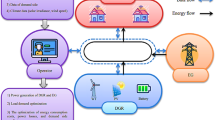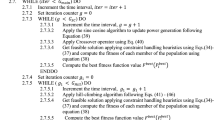Abstract
Economic/environmental power dispatch goals were to determine the optimal power generation from thermal plants to satisfy the given demand while diminishing operational costs and also minimizing emissions due to burning of fossil fuels. In this paper, economic and environmental scheduling problems are mathematically formulated by considering various system constraints like the valve point loading effect, ramp rate constraints, plug-in electric vehicle charging constraints, and generator’s capacity constraints. In this work, multiagent fuzzy reinforcement learning (MAFRL) is implemented for an effective elucidation for the economic/environmental power dispatch (EEPD) problem with multiple charging scenarios of plug-in electric vehicle and valve point loading of concern thermal power generators. Here, the EEPD is framed as a multiagent fuzzy reinforcement learning (MAFRL) tasks in which specific plug-in electric vehicles and power generating units act as multiple players for minimizing emissions due to fossil fuels and costs of power generation also satisfying charging constraints of plug-in electric vehicles and several thermal unit’s constraints. To prove the superiority of multiagent fuzzy RL, two standard test functions containing five and fifteen thermal generating units integrated with multiple charging scenarios of plug-in electric vehicles have projected. Numerical consequences and assessment with a numerous current solution methodologies show the potentiality of multiagent fuzzy reinforcement learning method in solving the EEPD problem.












Similar content being viewed by others
Abbreviations
- \(P_{g,t}^{\min }\) :
-
Minimum power limit of gth generator
- \(P_{g,t}^{\max }\) :
-
Maximum power limit of gth generator
- F ecd :
-
Cost function for economic dispatch
- F end :
-
Emission function for environmental dispatch
- a g, b g, c g :
-
Fuel cost coefficients of gth generator
- \({\alpha _g},{\beta _g},{\gamma _g},{\delta _g},{\eta _g}\) :
-
Emission coefficients of gth generator
- e g, f g :
-
Coefficients of rippling factor for gth thermal units
- B i,g, B 0,g, B 00 :
-
Coefficients of power loss
- P demand,t :
-
Load demand
- P ev,t :
-
Charging load of electric vehicles
- P loss,t :
-
Transmission loss
- RUg :
-
Ramp-up limits
- RDg :
-
Ramp-down limits
- P g, t :
-
Power generation of gth generator at time t
- ω :
-
Weighting factor
References
Wong, K.P.; Fung, C.C.: Simulated annealing based economic dispatch algorithm. IEE Proc. C Gener. Transm. Distrib. (1993). https://doi.org/10.1049/ip-c.1993.0074
Abido, M.A.: Environmental/economic power dispatch using multiobjective evolutionary algorithms. IEEE Trans. Power. Syst. (2003). https://doi.org/10.1109/TPWRS.2003.818693
Saber, A.Y.; Venayagamoorthy, G.K.: Resource scheduling under uncertainty in a smart grid with renewables and plug-in vehicles. IEEE Syst. J. (2012). https://doi.org/10.1109/JSYST.2011.2163012
Vandael, S.; Claessens, B.; Hommelberg, M., et al.: A scalable three-step approach for demand side management of plug-in hybrid vehicles. IEEE Trans. Smart. Grid. (2013). https://doi.org/10.1109/TSG.2012.2213847
Alizadeh, M.; Scaglione, A.; Davies, J.; Kurani, K.S.: A scalable stochastic model for the electricity demand of electric and plug-in hybrid vehicles. IEEE Trans. Smart. Grid. (2014). https://doi.org/10.1109/TSG.2013.2275988
Moura, S.J.; Fathy, H.K.; Callaway, D.S.; Stein, J.L.: A stochastic optimal control approach for power management in plug-in hybrid electric vehicles. IEEE Trans. Control. Syst. Technol. (2011). https://doi.org/10.1109/TCST.2010.2043736
Xu, Y.; Zhang, W.; Liu, W.: Distributed dynamic programming-based approach for economic dispatch in smart grids. IEEE Trans. Ind. Inform. (2015). https://doi.org/10.1109/TII.2014.2378691
Joned A.M.A.A.; Musirin I.; Rahman T.K.A.: (2006) Solving dynamic economic dispatch using evolutionary programming. In: First International Power and Energy Conference, (PECon 2006) Proceedings
Pothiya, S.; Ngamroo, I.; Kongprawechnon, W.: Ant colony optimisation for economic dispatch problem with non-smooth cost functions. Int. J. Electr. Power Energy Syst. 32, 478–487 (2010). https://doi.org/10.1016/j.ijepes.2009.09.016
Bhattacharya, A.; Chattopadhyay, P.K.: Biogeography-based optimization for different economic load dispatch problems. IEEE Trans. Power Syst. (2010). https://doi.org/10.1109/TPWRS.2009.2034525
Basu, M.: Economic environmental dispatch using multi-objective differential evolution. Appl. Soft Comput. 11, 2845–2853 (2011)
Bhattacharya, A.; Chattopadhyay, P.K.: Hybrid Differential evolution with biogeography-based optimization for solution of economic load dispatch. IEEE Trans. Power Syst. 25, 1955–1964 (2010). https://doi.org/10.1109/TPWRS.2010.2043270
Mondal, S.; Bhattacharya, A.; Nee Dey, S.H.: Multi-objective economic emission load dispatch solution using gravitational search algorithm and considering wind power penetration. Int. J. Electr. Power Energy Syst. (2013). https://doi.org/10.1016/j.ijepes.2012.06.049
Sivasubramani, S.; Swarup, K.S.: Environmental/economic dispatch using multi-objective harmony search algorithm. Electr. Power Syst. Res. 81, 1778–1785 (2011). https://doi.org/10.1016/j.epsr.2011.04.007
Sayah, S.; Hamouda, A.: A hybrid differential evolution algorithm based on particle swarm optimization for nonconvex economic dispatch problems. Appl. Soft. Comput. J. 13, 1608–1619 (2013). https://doi.org/10.1016/j.asoc.2012.12.014
Elaiw, A.M.; Xia, X.; Shehata, A.M.: Hybrid DE-SQP and hybrid PSO-SQP methods for solving dynamic economic emission dispatch problem with valve-point effects. Electr. Power Syst. Res. (2013). https://doi.org/10.1016/j.epsr.2013.05.015
Mohammadi-ivatloo, B.; Rabiee, A.; Soroudi, A.; Ehsan, M.: Imperialist competitive algorithm for solving non-convex dynamic economic power dispatch. Energy (2012). https://doi.org/10.1016/j.energy.2012.06.034
Anand, H.; Narang, N.; Dhillon, J.S.: Profit based unit commitment using hybrid optimization technique. Energy (2018). https://doi.org/10.1016/j.energy.2018.01.138
Zou, D.; Li, S.; Kong, X., et al.: Solving the combined heat and power economic dispatch problems by an improved genetic algorithm and a new constraint handling strategy. Appl Energy (2019). https://doi.org/10.1016/j.apenergy.2019.01.056
Anand, H.; Narang, N.; Dhillon, J.S.: Multi-objective combined heat and power unit commitment using particle swarm optimization. Energy (2019). https://doi.org/10.1016/j.energy.2019.01.155
Navin N.K.; Sharma R.: (2017) A modified differential evolution approach to PHEV integrated thermal unit commitment proble. In: 2016 IEEE 7th Power India International Conference, PIICON 2016
Navin N.K.; Sharma R.: (2017) A Gaussian shuffled differential evolution approach to economic load dispatch problem with valve point effect. In: Proceeding - IEEE International Conference on Computing, Communication and Automation, ICCCA 2016
Navin N.K.; Sharma R.: (2017) A Modified Differential Evolution approach to emission constrained thermal unit commitment problem. In: 1st IEEE International Conference on Power Electronics, Intelligent Control and Energy Systems, ICPEICES 2016
Narang, N.: Hydro-thermal generation scheduling using integrated gravitational search algorithm and predator–prey optimization technique. Neural Comput. Appl. (2018). https://doi.org/10.1007/s00521-016-2693-x
Zou, D.; Li, S.; Kong, X., et al.: Solving the dynamic economic dispatch by a memory-based global differential evolution and a repair technique of constraint handling. Energy (2018). https://doi.org/10.1016/j.energy.2018.01.029
Zhang, Y.; Gong, D.W.; Ding, Z.: A bare-bones multi-objective particle swarm optimization algorithm for environmental/economic dispatch. Inf. Sci. (Ny) (2012). https://doi.org/10.1016/j.ins.2011.06.004
Zhang, Y.; Gong, D.W.; Geng, N.; Sun, X.Y.: Hybrid bare-bones PSO for dynamic economic dispatch with valve-point effects. Appl. Soft. Comput. J. (2014). https://doi.org/10.1016/j.asoc.2014.01.035
Gong, D.W.; Zhang, Y.; Qi, C.L.: Environmental/economic power dispatch using a hybrid multi-objective optimization algorithm. Int. J. Electr. Power Energy Syst. (2010). https://doi.org/10.1016/j.ijepes.2009.11.017
Yang, Z.; Li, K.; Niu, Q., et al.: A self-learning TLBO based dynamic economic/environmental dispatch considering multiple plug-in electric vehicle loads. J. Mod. Power Syst. Clean Energy (2014). https://doi.org/10.1007/s40565-014-0087-6
Wiering, M.; van Otterlo, M.: Reinforcement Learning : State-of-the-Art. Springer, Berlin (2012)
Buoniu, L.; Babuška, R.; De Schutter, B.; Ernst, D.: Reinforcement Learning and Dynamic Programming Using Function Approximators. CRC Press, Boca Raton (2010)
Navin, N.K.; Sharma, R.; Malik, H.: Solving nonconvex economic thermal power dispatch problem with multiple fuel system and valve point loading effect using fuzzy reinforcement learning. J. Intell. Fuzzy Syst. (2018). https://doi.org/10.3233/JIFS-169776
Navin, N.K.; Sharma, R.: A fuzzy reinforcement learning approach to thermal unit commitment problem. Neural Comput. Appl. (2017). https://doi.org/10.1007/s00521-017-3106-5
Srinivasa Reddy, A.; Vaisakh, K.: Shuffled differential evolution for economic dispatch with valve point loading effects. Int. J. Electr. Power Energy Syst. 46, 342–352 (2013). https://doi.org/10.1016/j.ijepes.2012.10.012
Ma, H.; Yang, Z.; You, P.; Fei, M.: Multi-objective biogeography-based optimization for dynamic economic emission load dispatch considering plug-in electric vehicles charging. Energy (2017). https://doi.org/10.1016/j.energy.2017.06.102
States U.; Quality A.; Based A.: et al.: Environmental Assessment of Plug-In Hybrid Electric Vehicles. EPRI, July 1:1–10 (2007). https://www.energy.gov/sites/prod/files/oeprod/DocumentsandMedia/EPRI-NRDC_PHEV_GHG_report.pdf
Basu, M.: Dynamic economic emission dispatch using evolutionary programming and fuzzy satisfying method. Int. J. Emerg. Electr. Power Syst. (2007). https://doi.org/10.2202/1553-779X.1146
Gaing Z.L.; Ou T.C.: (2009) Dynamic economic dispatch solution using fast evolutionary programming with swarm direction. In: 2009 4th IEEE Conference on Industrial Electronics and Applications, ICIEA 2009
Hemamalini, S.; Simon, S.P.: Dynamic economic dispatch using artificial bee colony algorithm for units with valve-point effect. Eur. Trans. Electr. Power (2011). https://doi.org/10.1002/etep.413
Author information
Authors and Affiliations
Corresponding author
Rights and permissions
About this article
Cite this article
Navin, N.K. A Multiagent Fuzzy Reinforcement Learning Approach for Economic Power Dispatch Considering Multiple Plug-In Electric Vehicle Loads. Arab J Sci Eng 46, 1431–1449 (2021). https://doi.org/10.1007/s13369-020-05153-7
Received:
Accepted:
Published:
Issue Date:
DOI: https://doi.org/10.1007/s13369-020-05153-7




